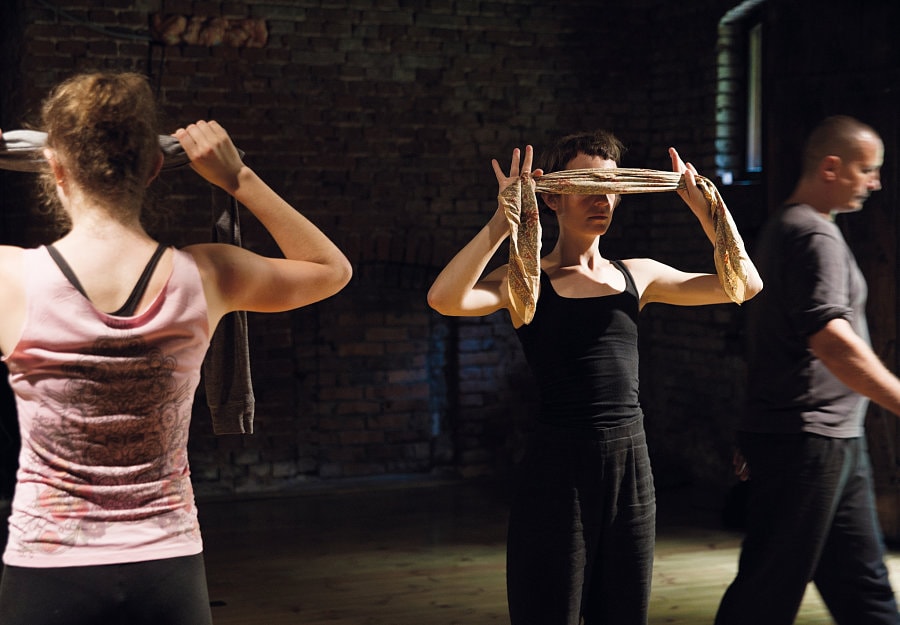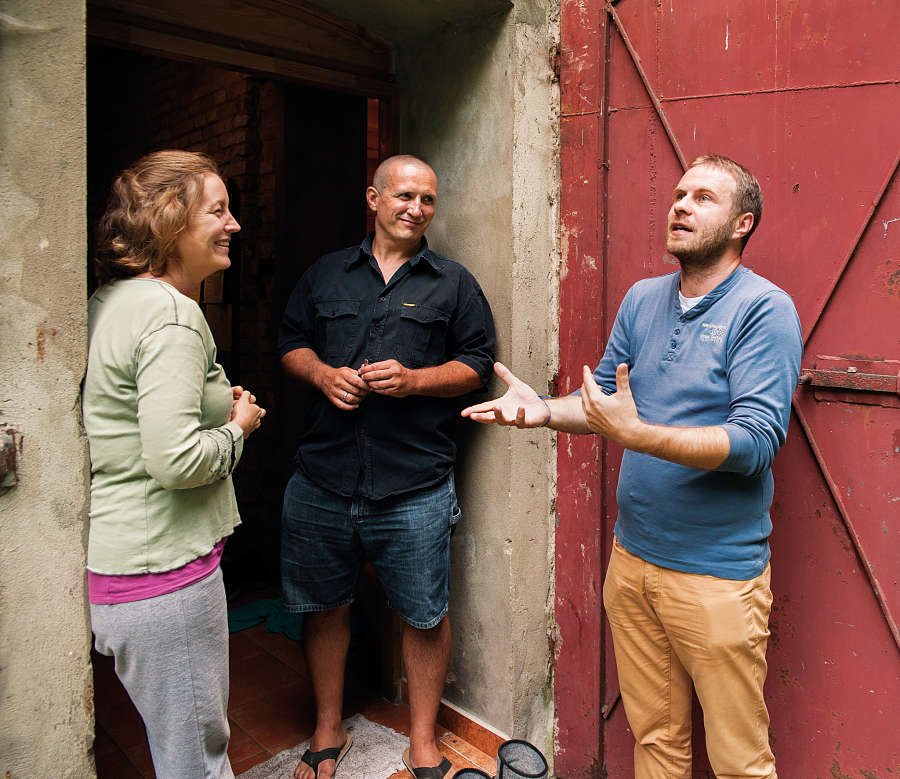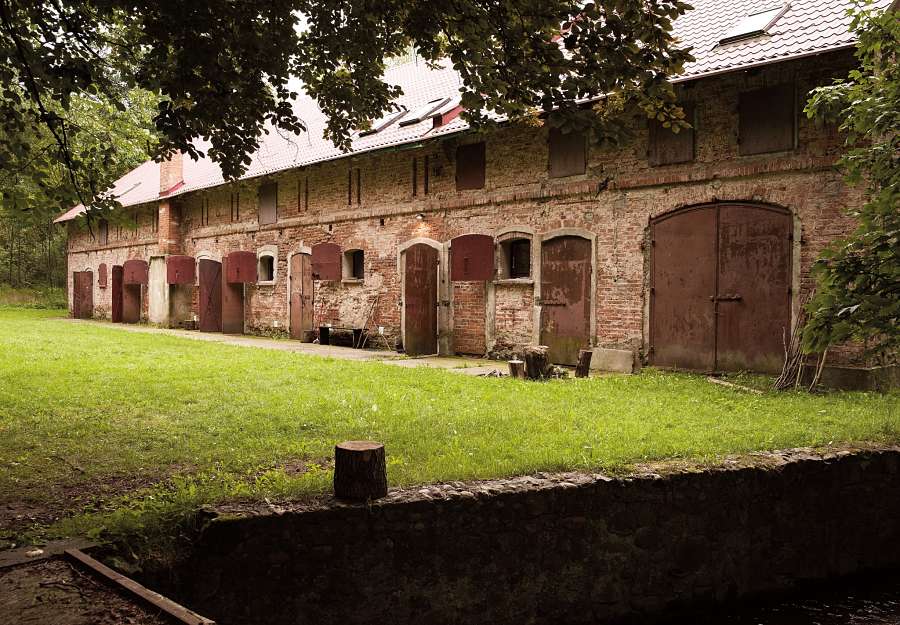My first sight of Jerzy Grotowski’s fabled workspace in the Polish woods came by torchlight. It was the summer of 2009, 10 years after the influential and eccentric performance theorist’s death, and I was one of several dozen theatre journalists, critics and academics invited to Wrocław, the city in western Poland where he once lived and worked, to celebrate what had been designated the Year of Grotowski.
One memorable evening during our stay, a group of us were bused about 25 miles northeast of the city to an isolated rural area called Brzezinka, to witness a performance in the impressive, barn-like brick structure that had been a home, in Grotowski’s lifetime, for his exploratory work in paratheatre and Theatre of Sources, and later for the workshops and long-term projects of the Wrocław-based Grotowski Institute. At an unmarked spot on the highway, we debarked from the bus and followed our Polish hosts, who lit the way with several homemade torches, down a dirt road into dense, silent woods.
Perhaps a quarter of a mile into the forest, the building came into view. Situated on a tree-lined swath of lawn, it is adjacent to a moss-covered wooden watermill and a burbling stream, framed on the right by a stretch of decaying stone wall. The windows and doors of the old structure, animated by the flickering torches, peered at us darkly through the gloom. There was a kind of obscure magic coursing through the place. I wondered if the others sensed it too.
Taking my leave of Brzezinka after the performance that night, I remember thinking, “This is it. I’ll never quite know this feeling again.”
Read more about the participating artists here and about Teatr ZAR’s controversial production of ‘Armine, Sister’ here.
But some five years later, I was invited back to Brzezinka, this time to spend several days there in the company of a remarkable crew of theatremakers, some American and some Polish, all of whom, I have no doubt whatsoever, shared my sensitivity to the magical qualities and portentous vibrations of the place, whether or not we ever spoke about it.
The occasion, this past August, was a two-week training workshop for the eight-member cast of Cutting Ball Theatre of San Francisco’s new production of Sophocles’ Antigone, scheduled to begin performances Feb. 19 at the company’s home theatre in the Tenderloin.
The stint in Poland for her cast had been arranged by director Paige Rogers, the 48-year-old co-artistic director of Cutting Ball, the experimental company she and her husband Rob Melrose founded together in 1999. Rogers and Melrose, who were inspired by a grant-funded year they spent in Europe observing master directors in France, Germany, Italy and Austria, have consistently drawn upon European models and influences to fashion Cutting Ball’s programming. For Rogers, the immersion of her Antigone actors into Grotowskian training—at the authentic locale where it was developed by the man himself, and where it remains the gold standard for his still-devoted acolytes—was a hard-won dream come true.
It was Rogers’s encounter in Los Angeles in 2007 with the physically rigorous and aesthetically uncompromising work of Teatr ZAR—the multinational resident company of the Grotowski Institute and a principal inheritor of Grotowski’s performance techniques (AT, Dec. ’09)—that set her dream in motion. To her chagrin, she’d missed ZAR’s somber, ritualistic, musically transporting Gospels of Childhood trilogy at the Dialog Festival in Poland some months before, and, intent upon correcting the omission, she headed to UCLA Live to see the company’s U.S. debut. Her response, she says, was off the charts.
“I’d always loved both music and theatre,” Rogers reflects, “but the two were divided for me into different worlds—they didn’t cross over. ZAR changed that. The two came together, and it gave me back my faith in the power of theatre.” Her fascination, which grew with her participation in several ZAR workshop sessions, led in 2012 to Tontlawald, a genre-stretching Cutting Ball production (with text by resident writer Eugenie Chan) based on an old Estonian fairy tale, in which Rogers and codirector Annie Paladino channeled ZAR’s musical and physical techniques.
Then, when she and Melrose settled upon Antigone as part of Cutting Ball’s 2014–15 lineup—the play’s themes of struggle between the individual and the state, between tyrannical power and civil disobedience, seemed particularly timely—Rogers couldn’t shake the itch to plunge full-tilt into ZAR’s methodology. So when she met up with the company’s founder and artistic director, Jarosław Fret, at the 2013 Dialog Festival, she proposed a hookup between the two companies: If she could transport her cast to Poland, could she enlist ZAR’s experienced music and movement coaches to train them? Fret was enthusiastic.
But what about the price tag, which Rogers figured might tally $16,500? She and her Antigone team launched a Kickstarter campaign to raise funds for travel and training, and by the late summer of 2014, the sum was raised, tickets were bought, and the show’s eight recently cast West Coast actors—most of whom knew little to nothing about Jerzy Grotowski—were packing for a trip that would change their lives.
Familiarity, it turns out, doesn’t render Brzezinka’s magic any less potent. At night, the silence in the compound is overwhelming. More stars than you ever imagined existed dot the sky. By morning, dew glistens on the grass, and you sip your coffee to the accompaniment of the millstream’s gurgling. Trails lead from the mill into the forest, where water birds snorkel in the nearby marshes; in another direction, deer graze in a roadside meadow, unfazed by the sight of human intruders. The actors talk about a particular brown fox that has been spotted three separate times in the underbrush.

on a blindfold exercise. (Photo by Magdalena Madra)
But nature is a tangent; it’s in Brzezinka’s rehearsal spaces, where theatrical intensity seems to hang in the air like whispery echoes, that the actors spend their working days. Early mornings, they assemble in an upstairs studio, bare except for an electronic keyboard, a heater perched on cinderblocks and a stack of blankets for use in floor work, to take part in polyphonic singing exercises led by ZAR regulars Aleksandra Kotecka, known as Ola, and Tomasz Wierzbowski. The decidedly unmusical sounds of howling, growling and shrieking start the session off.
Ola, 29, and Tomasz, 30, are a couple—they’ve known each other since their student days, and have been members of the ZAR company since it officially formed in 2002. They’ve led workshops on ZAR’s musical research and methodology (inspired by Grotowski’s late-career immersion in archaic music) in India, Brazil and elsewhere. “This is the first time someone has asked us to work with a set group of actors with a production as the target,” Tomasz observes. Their work is less about creating a musical score for Antigone than it is about refining the ensemble’s attentiveness, listening skills and musical presence. Among the songs they’re polishing are several Georgian folk melodies that date back centuries, some of which may make it into the show; and (believe it or not) familiar refrains like “How Are Things in Glocca Morra?” from Finian’s Rainbow and the African spiritual “Siya Hamba,” the latter songs being vehicles for Rogers’s infatuation (which dates to her childhood) for barbershop-style harmonics.
As gray morning light pours in through six slanted windows, the actors, barefoot on the polished pine floor, face each other in a tight circle to sing scales that break into harmonies. Responding to Ola’s gentle hand gestures, they morph from aaa to eee to mee. “When you’re not singing, take deep breaths as though you were,” Ola advises.
Zeroing in on one four-bar melody, the actors repeat its complex, contrapuntal harmonies as they move into different configurations, listening intently to each other as their positions change. “Let’s focus on fluctuation, on how the sounds are connected to one another,” Tomasz interjects. He demonstrates how to catch a breath within the stream of sound—“We have to blend into the song, to be invisible inside it, you understand?”—and as the actors’ movements grow more challenging (crouching, stretching, assuming extreme postures), presses them to stay relaxed: “You need to be together, equal, invisible, one body. If there is a person outside this room who knows your voice, he must not be able to tell whether you are singing or not.”
Another exercise sends the actors into gales of laughter at the effects they manage to produce. Singing a passage that repeats the syllables “All-e-lu-i-a,” they perform it first as a hymn, then (as Tomasz instructs) brusquely, like soldiers in a Russian military choir; romantically, as though it were a movie love song; cloyingly, like a child’s lullaby; and like ghosts might sing it in a spooky cartoon, with high shrieks and sliding harmonics.
Movement and body work— initially taught by ZAR collaborator Matej Matejka and (at the sessions this writer observed) by company member Przemysław Błaszezak, a muscular, good-humored actor nicknamed Pshemik—take place in the workspace’s large ground-floor studio. In rigorous sessions of three to four hours, the actors progress from breathing and stretching to combat with poles and kicks, simulated flying, in-tandem falling. “Swallow the air deep down to the bottom of the diaphragm,” advises Pshemik, in smooth, accented English. “You block your breathing, you double your efforts.”
After a follow-your-eyes-wherever exercise and a pelvic relaxation exercise not unlike twerking, Pshemik shifts the focus more emphatically to floor work. “We have to teach our bodies how to meet the floor relaxed, in one flow, softly and quietly,” he counsels, as the actors practice collapsing singly or in heaps. “Without losing contact with the floor, get familiar with its surface. The floor is your best friend: It is always in the same place, there forever. Your partner may be out of place, but the floor is always here.”
Hours into the session, Pshemik adds a soundtrack of recorded music and instructs the actors to move continuously wherever their bodies take them—“Don’t fall into a picture of how you should be! Just follow your body all the time,” he intones—and the results are startling. Wiley Naman Strasser, the lean-limbed dancer who portrays Haemon, weaves eloquently and purposefully through the space, as does Jason W. Wong, the athletic actor who plays his father Kreon. Hannah Donovan, cast as Antigone’s daughter Ismene, skips like an Audrey Hepburn sprite, childish and jazzy; Emma Crane Jaster, who plays Eurydice and has a background in mime and clowning, could be performing a Merce Cunningham solo. Tim Green, a stocky fellow cast as the messenger, slouches and sways, and seems to enter a dream state with head down, arms thrashing; Madeline H.D. Brown, the London-trained blonde playing Antigone, is slack-jawed and hip, her fingers dancing as avidly as her torso. Pshemik has elicited revealing, one-of-a-kind movement from each performer.
“In the text of this play there are so many beautiful pictures hidden,” he tells the wrung-out octet as they reach for towels and water bottles at the session’s end. “Antigone could be done without a single word.”
There will, however, be words. Rogers commissioned a new Antigone translation based, she says, on two questions: First, “What does Sophocles’ original text really, literally say?”, followed by “How can we create the same feeling in the room today that his play did for the Greeks?” Meeting that challenge fell to Daniel Sullivan, an Alameda-based writer with a working knowledge of Greek who came to Rogers’s attention after he regaled her with “the longest e-mail ever,” revealing that he was gob-smacked by her Tontlawald, which he’d seen four times, and was eager to work in a similar mode. She said yes, and the two became what Rogers calls “best buddies” for several ensuing weeks. Sullivan dropped in for a four-day taste of the Brzezinka experience as well.
“After a yearlong process of translating, writing and working together, Daniel is ready to drive the script back into the station,” Rogers said at year’s end, prior to calling her cast back together in San Francisco in January for a final stretch of rehearsal. “Daniel gilded many lilies before honing in on what I consider to be a fairly muscular and certainly beautiful script.”

Indeed, Sullivan’s text focuses efficiently on the fallout of Antigone’s ill-fated refusal to let her brother’s body go unconsecrated while preserving a generous measure of the Chorus’s poetic exhortations. It is not so much updated as infused with booster shots of vulgarity and anachronism: “All her blooded-ancestor, family-line bullshit,” Kreon exclaims after a standoff with Antigone. “All this earth-gods-gave-her-this, blah-blah-blah. So fucking fatiguing.” In another passage that concludes, “To be a bit blunt,” Sullivan has Antigone herself mutter the f-word a dozen times.
Back home and poised to reenter Antigone rehearsals full-time, the eight cast members are uniform in their view that Brzezinka was not just an invaluable boon to the production but a gateway experience in their personal development as actors. “We’ve built up those ensemble muscles in a way that doesn’t usually happen,” offers Paul Loper, the professional dancer who plays blind Tiresias. “It provided us time for connecting, risking, responding to each other, blending ourselves into a team. What could be better than that?”
“Having lived together puts us so far ahead in terms of communication and understanding,” Strasser stresses. “We have all that generative work we did there to draw upon and fall back on.” Jaster, who sees the training experience as “taking collective responsibility” for the production, echoes Rogers when she marvels about the Grotowskian melding of theatrical and musical realms. Wong (who in addition to playing Kreon has assumed responsibility for the show’s costume design) is certain that “everything we accomplished is going to stay with us into final rehearsals—we’re going to be trying to recreate moments we had there.”
Recreating those moments will surely be less of a challenge now that Rogers has rustled up additional funding to bring her ZAR vocal specialists, Ola and Tomasz, to San Francisco for additional interaction with the cast during February rehearsals, about which they’re uniformly delighted. She’s also been busy creating a film—she calls it “the sibling duet”—that will greet Antigone audiences in the lobby of the theatre as a complement to the production.
“Antigone is a kind of puzzle,” Rogers reasons, “involving four siblings born of an incestuous relationship. In addition to the girls, Antigone and Ismene, there’s Eteocles and Polynices, the two brothers who don’t appear onstage—and who, when the play begins, have in fact killed each other. At Brzezinka, Matej Matejka had time to choreograph this duet that the siblings all perform with each other, reflecting their common experiences. This movement piece with variations will provide the audience with a kind of emotional backstory on film before they experience the play.” (Rogers has cast two additional actors to play Eteocles and Polynices for the film segment only.)
So how much of Brzezinka finds its way into Antigone performances remains to be seen. Rogers has been thinking, back in San Francisco, about an exercise ZAR’s Pshemik conducted with her actors in which they played scenes and improvised movement blindfolded. “All the characters of Antigone are blind,” the trainer theorized at the time, “except perhaps Tiresias.”
The blindfolds, though, served less to simulate blindness—moral, ethical or otherwise—than they did to mandate introspection and intense self-attentiveness. The raw materials required to give life to Sophocles’ characters, Pshemik knew, were there in the actors’ bodies, ensconced deep in their memories, associations, emotions. The journey inward to retrieve them was the key.


